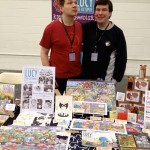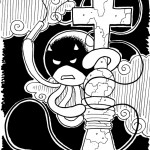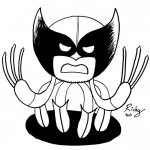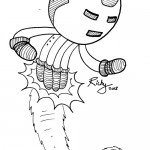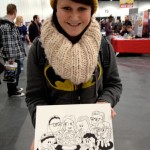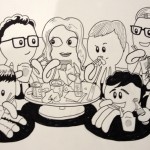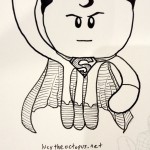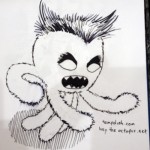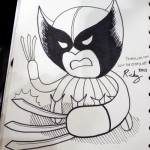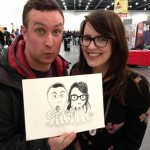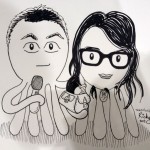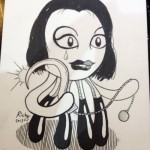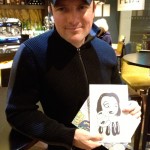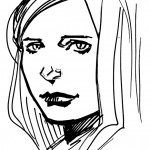So for #63 of my webcomic Lucy the Octopus I wanted a moment for Lucy, and the reader, to pause and reflect after a trying time. This is the end of a story that takes place over a couple of days in Lucy’s world, but took over four months in real time with one strip coming out every week.
Doing one large pretty panel in watercolour seemed like a nice way to do it…
I’m used to doing Lucy seascapes now, so pencilled it out without too much fuss. I did try to keep the pencil lines cleaner and tighter than normal as I didn’t want too many pencil marks visible under the watercolours. It’s not possible to erase pencils efficiently once they’ve got a layer of paint over them.
For those not used to watercolours, the basic idea is to build up layers of paint, starting with the lightest colour in any given area…

I use a Pro Arte Acrylix brush (size 3). It’s actually designed for acrylic paints, so it’s durable and keeps its shape. As a vegetarian I try to avoid buying stuff made of animal bits, so I also chose these brushes because they’re synthetic rather than horsehair. I use these when inking too.
After doing the edges of any given patch of colour I may switch to a larger brush to [WARNING – TECHINICAL TERM COMING UP]… fill in the big bits.
It’s nice to have a range of colours from light to dark so I make sure I leave some paper showing through where the light catches the large yellow rock formation.

When adding a layer of watercolour over an existing layer, the wetter the bottom layer is, the more the top layer will run into the bottom. This makes for a softer transition between the two. I’ve done a bit of this in the large blue sea area at the top of the page.
Where I want a sharper edge to the area of colour, I make sure the layer below is dry. You can see my hairdryer is always on hand for this! This would be the case for the darker tone on the majenta coloured plants.

A close up of Lucy and Puffy.
Mainly at this point I’m mapping out basic colours, and will add further tones later.
I make sure the paint is dry before adding colour to a connecting area of the paper. That way I can avoid, for example, the blue on Lucy’s arm running into the yellow of Puffy’s fin, resulting in a weird green that I would then have to disguise as seaweed.
Lucy looks odd without the black in her eye, but I must be patient!

Notice my watercolour set that dates back to at least the seventies. I’ve had it myself since I was a kid, but I think my mum may have used it before me. It’s made by a company called Page. It includes some small tubes of what was once wet water based paint but has long since dried up. I still keep them in there because I like the look of them!
Anyway, all areas of the picture have at least one layer of paint on them now, so I can get a sense of the colours balancing.

A second layer of watercolour can be the same colour as the first, making the area richer and darker.
You can also use a different colour for subsequent layers, such as where I’ve used a light orangey brown on top of the yellow in the large rock formation.

Adding more tone and [WARNING – ANOTHER TECHINICAL TERM COMING UP]… splotches, to plants.

Here we can see my highly professional desk set up…
- Paper napkins in case of spills or mistakes
- Lucky Charms mug full of water for brush rinsing
- Copy of Lucy the Octoups: Better in Small Doses for reference
- Scrap paper to scribble notes and check the look of watercolours (they look very different to their dry in the box form)
- The painting paper is a page from a Winsor & Newton Cotman Water Colour Pad. I rest it on the pad so I can angle the painting slightly as I paint, not enough for the paint to run, but enough that I don’t get back ache hunched over it.

This is all the watercolouring done. Few speckles for sponge plants and rock texture. A few more for general bits and pieces floating around in the ocean.
Also check out my shoeless feet. Always paint without shoes on.
It is more bohemian so your art will be artier.
 On a separate piece of paper, I mark out where the lettering will sit – I have already laid this out on my Mac. I then draw the speech bubbles with a drawing pen.
On a separate piece of paper, I mark out where the lettering will sit – I have already laid this out on my Mac. I then draw the speech bubbles with a drawing pen.
I will scan both pages and layer them using Photoshop.
I may want to turn the original painting into a print or postcard at some point, without any text.
I don’t know why I taped the painting to my drawing board to ink it. I took the tape straight off again as I find it easier to ink, being able to turn the paper freely.

At last I can add the dark of Lucy’s eyes and she looks like herself!
I inked over the watercolours with Staedtler Pigment Liner drawing pens. Mainly 0.5, a bit of o.3 and 0.8 too.
 It’s fun doing the black lines. They define each area of colour, bringing the picture to life.
It’s fun doing the black lines. They define each area of colour, bringing the picture to life.

I add a bit of coloured pencil for the outline of the bubbles and Lucy’s patches, and some texture on the big rock formation.
I leave the rear rock formation without an outline. This leaves it looking less defined and further away.

So there you go!
If you want to see the final lettered comic it’s #63 though if you don’t want to read this final page of the story before the beginning, the start of the story is here!
Cheers!
 Come along to this fantastic free event. As well as my presentation you can listen to Andy Poyiadgi talking through putting together his exhibition for The Lakes comics festival and Lorenzo Fiorini will be talking about an instructional essay on storytelling visually that he was given by Eduardo Risso (100 Bullets, Batman: Noir).
Come along to this fantastic free event. As well as my presentation you can listen to Andy Poyiadgi talking through putting together his exhibition for The Lakes comics festival and Lorenzo Fiorini will be talking about an instructional essay on storytelling visually that he was given by Eduardo Risso (100 Bullets, Batman: Noir).







































